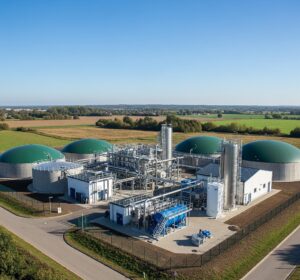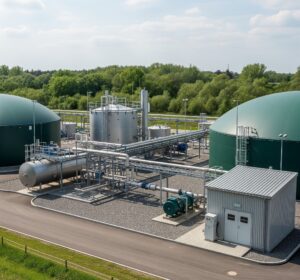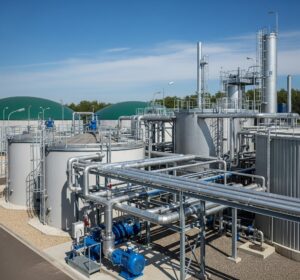Biogas Analyzers
Biogas Production Industry
Biogas production is a cornerstone of sustainable energy and waste management, transforming organic waste into a valuable, renewable resource. This anaerobic digestion process offers multifaceted benefits, from reducing greenhouse gas emissions and managing waste effectively to promoting energy independence and creating a nutrient-rich biofertilizer. As the world increasingly seeks greener energy solutions, the efficiency and safety of biogas plants become paramount.
is a cornerstone of sustainable energy and waste management, transforming organic waste into a valuable, renewable resource. This anaerobic digestion process offers multifaceted benefits, from reducing greenhouse gas emissions and managing waste effectively to promoting energy independence and creating a nutrient-rich biofertilizer. As the world increasingly seeks greener energy solutions, the efficiency and safety of biogas plants become paramount.
The Power of Biogas: A Sustainable Solution
Biogas, primarily a mixture of methane (CH₄) and carbon dioxide (CO₂), is generated when organic materials like agricultural waste, manure, and food scraps break down in an oxygen-free environment. This process mitigates the release of potent greenhouse gases like methane into the atmosphere, which would otherwise occur in landfills. The resulting biogas can be used for electricity generation, heating, cooking, and even as vehicle fuel, offering a versatile and decentralized energy source. Furthermore, the digestate byproduct serves as an excellent organic fertilizer, enhancing soil quality and reducing reliance on chemical alternatives.
 The Critical Need for O₂ Analysis in Biogas Applications
The Critical Need for O₂ Analysis in Biogas Applications
While anaerobic digestion thrives in oxygen-depleted conditions, precise oxygen (O₂) analysis is an absolute necessity throughout the biogas production cycle for several critical reasons:
- Process Efficiency and Methane Yield: The microorganisms responsible for biogas production, particularly methanogenic bacteria, are highly sensitive to oxygen. Even small amounts of O₂ can inhibit their activity, reducing the overall biogas yield and lowering the methane content. Continuous O₂ monitoring in the digester headspace ensures optimal conditions for microbial activity, maximizing methane production and thereby the energy value of the biogas.
- Safety and Explosion Prevention: Biogas is a flammable gas. The presence of oxygen can create a dangerous, explosive mixture within the digester, pipelines, and storage tanks. Real-time O₂ analysis is crucial for detecting air leaks and preventing the formation of hazardous conditions, protecting personnel and equipment from potentially catastrophic events.
- Gas Quality and Utilization: For biogas to be effectively utilized, especially for upgrading to biomethane (renewable natural gas) for grid injection or vehicle fuel, its quality must be consistently high. Oxygen contamination reduces the heating value of the gas and can interfere with purification processes designed to remove impurities like hydrogen sulfide (H₂S) and CO₂. Accurate O₂ measurement ensures that the biogas meets the required specifications for its intended application.
- Corrosion Prevention: Oxygen is a reactive element that can accelerate corrosion within biogas infrastructure, including digesters, pipelines, and storage tanks. Monitoring O₂ levels helps in implementing preventive measures, extending equipment lifespan, and reducing maintenance costs.
 Optimizing Upgrading Processes: In biogas upgrading, where impurities are removed to produce high-purity biomethane, oxygen can negatively impact the efficiency of certain treatment technologies. Precise O₂ measurement in the raw biogas stream allows for optimization of these upgrading processes, ensuring cost-effectiveness and maximizing biomethane purity.
Optimizing Upgrading Processes: In biogas upgrading, where impurities are removed to produce high-purity biomethane, oxygen can negatively impact the efficiency of certain treatment technologies. Precise O₂ measurement in the raw biogas stream allows for optimization of these upgrading processes, ensuring cost-effectiveness and maximizing biomethane purity.
- Hydrogen Sulfide (H₂S) Removal: In some biogas plants, controlled micro-aeration (introduction of small amounts of oxygen) is used to remove H₂S, a corrosive and toxic gas. Accurate O₂ dosing, guided by precise oxygen analysis, is essential for this process to be effective without negatively impacting methane production or creating hazardous conditions.
Advanced O₂ Analyzers for Biogas
Modern process analyzers employ sophisticated technologies like optical quench luminescence and electrochemical sensors to provide accurate and reliable oxygen measurements in biogas applications. These analyzers are designed to operate in challenging environments, often resistant to common biogas contaminants like H₂S and CO₂. They offer features such as real-time continuous monitoring, wide measuring ranges (from percent levels in wet biogas to trace ppm levels for biomethane), low maintenance, and robust construction suitable for hazardous areas.
By integrating advanced O₂ process analyzers, biogas plant operators can ensure optimal digester performance, enhance safety, maintain gas quality, and maximize the economic and environmental benefits of biogas production

